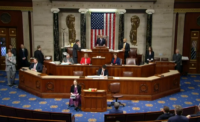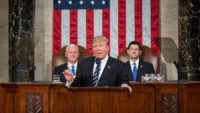Add many architects to the various groups—like environmentalists, the poor, the elderly, and people with disabilities—who are distressed by Donald Trump’s 2018 budget proposal. The president, in a preliminary proposal released Thursday, envisions steep cuts to, or outright elimination of, many programs that architects say benefit their profession. With Trump looking to dramatically scale back domestic discretionary spending across the board, the programs at risk cover a wide array of issues, including housing, transportation, arts, and urbanism.
Here are some of the main programs—as identified by architecture lobbyists and housing advocates—at risk:
-
Community Development Block Grants (CDBG). Trump wants to eliminate this $3 billion U.S. Department of Housing and Urban Development (HUD) program—one of the agency’s longest running—which has previously enjoyed bipartisan support. Grants go to local governments for building and improving public facilities such as parks, health care clinics, senior centers, and for neighborhood rehabilitation efforts.
-
Affordable housing programs within HUD. Overall, Trump would cut HUD by 13 percent, or $6.2 billion. The National Low Income Housing Coalition says that would threaten housing vouchers for hundreds of thousands of families.
-
Smart growth-friendly programs in HUD and the Department of Transportation (DOT). The Obama administration made a point of getting federal housing, transportation, and environmental remediation efforts out of their silos and working together on comprehensive community sustainability. Trump proposes to eliminate most of the programs that remain from that initiative, such as Choice Neighborhoods in HUD and Transportation Investment Generating Economic Recovery (TIGER) grants in DOT.
Choice Neighborhoods takes a more well-rounded approach than typical affordable housing programs by working with communities to develop strategies for complementary policies like improved safety, public spaces, and schools. TIGER is a competitive, discretionary grant program (the vast majority of DOT funds are handed out to states by formula) designed to support innovative projects, such as multi-modal developments and transportation upgrades that are coordinated with related efforts like affordable housing development or brownfield cleanup. “TIGER really supports the principles of strong vibrant communities,” says Andrew Goldberg, managing director of government relations at the American Institute of Architects. “TIGER grants have been a generator of activity and development in communities all over the country.”
-
National Endowment for the Arts (NEA). Trump would abolish it. That means losing the agency’s design and creative placemaking programs and the Mayors Institute on City Design, which teaches mayors how to be their cities’ chief urban designer. “The NEA does a lot more than just support art exhibits or symphonies,” says Goldberg. “It does a lot of grant work on placemaking, working with mayors and local officials, community design and planning.”
- Energy Star. This Environmental Protection Agency (EPA) program is slated for elimination. More than 700 architectural firms sent a letter to EPA administrator Scott Pruitt on Thursday making their displeasure known. “Several Energy Star tools are vital for architects conducting energy efficient design work,” they note.
If Congress does pass a budget, rather than following the recent practice of continuing current funding levels in the face of legislative gridlock, few of these proposed cuts would be fully enacted. Even many Republicans would object to some of them. Stephen Glaude, CEO of the Coalition for Nonprofit Housing and Economic Development and a former HUD undersecretary in the first Bush administration, for example, told CNBC that he finds the prospect of ending CDBG “alarming.”
But the real cause for alarm is not the unlikely chance that popular programs like CDBG will actually be zeroed out; rather, it’s the president’s vision to do so.




